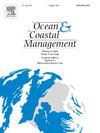优化东海海上风电场选址的新方法
IF 5.4
2区 环境科学与生态学
Q1 OCEANOGRAPHY
引用次数: 0
摘要
海上风电场的长期规划对风能的可持续利用至关重要。目前,中国海上风电场的选址在很大程度上受政策优先级的指导,往往缺乏对风能资源评估和社会生态考虑的整合。这可能导致项目效率下降,生态和环境成本上升。本研究提出了一种结合多源异构数据的方法,使风能、生态和经济数据集能够耦合。利用德尔菲法(Delphi)和地理信息系统(GIS),基于风能效应、生态影响和经济成本制定了情景。结果表明,ERA5数据与区域风能表现高度一致。在风能情景下,高适宜性站点主要位于福建北部和浙江南部海上50 ~ 75 km,面积为142,114 km2。在生态情景中,中等适宜性站点至少位于近海110 km处,高适宜性站点至少位于近海260 km处。虽然生态干扰随着离岸距离的增加而减少,但经济成本增加。在经济情景中,高适宜性地点位于离岸90-150公里范围内,覆盖面积为150,769平方公里。通过情景指标加权,最终确定风电场高适宜性优化海域总面积为179,904 km2,其中6106.83 km2分布在福建北部近海95 km海域,其余分布在近海250 km以上海域。此外,目前的风电场主要位于低、中适宜性地区,强调了高适宜性地区未来风电发展的潜力。这种新颖的方法为优化中国海上风电场选址提供了一个实用的工具,并提供了一个可转移的框架,适用于其他国家和地区的可用多源数据,支持更平衡和可持续的海上风电开发。本文章由计算机程序翻译,如有差异,请以英文原文为准。
A novel approach to optimize offshore wind farm siting in the Eastern China Sea
Long-term planning of offshore wind farms is essential for sustainable wind energy utilization. Currently, offshore wind farm siting in China is largely guided by policy priorities, often with insufficient integration of wind energy resource assessments and socio-ecological considerations. This may result in diminished project efficiency and elevated ecological and environmental costs. This study proposed a methodology that combined multisource heterogeneous data, enabling coupling of wind, ecological, and economic datasets. Using the Delphi method (Delphi) and Geographic Information System (GIS), scenarios were developed based on wind energy effects, ecological impacts, and economic costs. The results showed that ERA5 data was highly consistent with the regional wind energy performance. In the wind energy scenario, the high suitability sites were mainly located 50–75 km offshore in northern Fujian and southern Zhejiang, with an area of 142,114 km2. In the ecological scenario, the medium suitability sites were located at least 110 km offshore, and the high suitability sites were at least 260 km offshore. Although the ecological disturbance decreases with increasing offshore distance, the economic cost increases. In the economic scenario, the high suitability sites were located within 90–150 km offshore and covered an area of 150,769 km2. The total area of optimized high suitability sea area for wind farms was finally identified as 179,904 km2 through the weighting of the scenario indicators, of which 6106.83 km2 was located in the northern part of Fujian, 95 km offshore, and the rest of it was distributed in the sea area beyond 250 km offshore. In addition, current wind farms were mainly located in areas of low and medium suitability, emphasizing the potential for future wind power development in areas of high suitability. This novel approach provides a practical tool for optimizing offshore wind farm siting in China and offers a transferable framework applicable to other countries and regions with available multisource data, supporting more balanced and sustainable offshore wind development.
求助全文
通过发布文献求助,成功后即可免费获取论文全文。
去求助
来源期刊

Ocean & Coastal Management
环境科学-海洋学
CiteScore
8.50
自引率
15.20%
发文量
321
审稿时长
60 days
期刊介绍:
Ocean & Coastal Management is the leading international journal dedicated to the study of all aspects of ocean and coastal management from the global to local levels.
We publish rigorously peer-reviewed manuscripts from all disciplines, and inter-/trans-disciplinary and co-designed research, but all submissions must make clear the relevance to management and/or governance issues relevant to the sustainable development and conservation of oceans and coasts.
Comparative studies (from sub-national to trans-national cases, and other management / policy arenas) are encouraged, as are studies that critically assess current management practices and governance approaches. Submissions involving robust analysis, development of theory, and improvement of management practice are especially welcome.
 求助内容:
求助内容: 应助结果提醒方式:
应助结果提醒方式:


